
| Home | Store | NU Perches | Trees & Stands | Trained Parrot Blog | Parrot Academy | Videos |
List of Common Parrots:Parakeets:
Budgerigar (Budgie) Alexandrine Parakeet African Ringneck Indian Ringneck Monk Parakeet (Quaker Parrot) Parrotlets: Mexican Parrotlet Green Rumped Parrotlet Blue Winged Parrotlet Spectacled Parrotlet Dusky Billed Parrotlet Pacific Parrotlet Yellow Faced Parrotlet Lovebirds: Peach Faced Lovebird Masked Lovebird Fischer's Lovebird Lilian's (Nyasa) Lovebird Black Cheeked Lovebird Madagascar Lovebird Abyssinian Lovebird Red Faced Lovebird Swindern's Lovebird Lories and Lorikeets: Rainbow Lorikeet Conures: Sun Conure Jenday Conure Cherry Headed Conure Blue Crowned Conure Mitred Conure Patagonian Conure Green Cheeked Conure Nanday Conure Caiques: Black Headed Caique White Bellied Caique Poicephalus Parrots: Senegal Parrot Meyer's Parrot Red Bellied Parrot Brown Headed Parrot Jardine's Parrot Cape Parrot Ruppell's Parrot Eclectus: Eclectus Parrot African Greys: Congo African Grey (CAG) Timneh African Grey (TAG) Amazons: Blue Fronted Amazon Yellow Naped Amazon Yellow Headed Amazon Orange Winged Amazon Yellow Crowned Amazon Cockatoos: Cockatiel Galah (Rose Breasted) Cockatoo Sulphur Crested Cockatoo Umbrella Cockatoo Moluccan Cockatoo Bare Eyed Cockatoo Goffin's Cockatoo Macaws: Red Shouldered (Hahn's) Macaw Severe Macaw Blue And Gold Macaw Blue Throated Macaw Military Macaw Red Fronted Macaw Scarlet Macaw Green Winged Macaw Hyacinth Macaw Glossary of Common Parrot Terms |
About Michael Sazhin and the Trained Parrot BlogIntroduction by Mona Delgado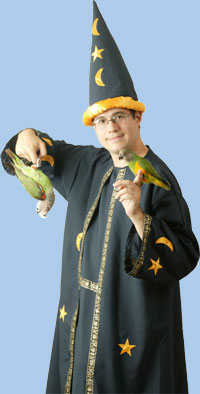
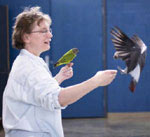 I have known Michael via the internet for about a year and a half. I met him on the Freeflight list and decided to correspond with him because he was training a Senegal hen parrot much like my Babylon. To Michael's credit, he started out learning quite a few cued trick behaviors and then realized that Kili would be a much better companion if he quit clipping her wings and started to develop her flight skills. Within the first 6 months of owning Kili, Michael taught her about 10 cued behaviors. Trick training really is the basis for flight training so it was fun to watch Michael's youtube videos and see him progress. Michael is also fascinated with the theory behind behavioral modification techniques. He is a strong proponent of using the clicker to train and took it to an innovative level when he started working on expanding Kili's abilities to flighted behaviors.
I have known Michael via the internet for about a year and a half. I met him on the Freeflight list and decided to correspond with him because he was training a Senegal hen parrot much like my Babylon. To Michael's credit, he started out learning quite a few cued trick behaviors and then realized that Kili would be a much better companion if he quit clipping her wings and started to develop her flight skills. Within the first 6 months of owning Kili, Michael taught her about 10 cued behaviors. Trick training really is the basis for flight training so it was fun to watch Michael's youtube videos and see him progress. Michael is also fascinated with the theory behind behavioral modification techniques. He is a strong proponent of using the clicker to train and took it to an innovative level when he started working on expanding Kili's abilities to flighted behaviors.
Michael's educational background includes studying techniques from the birdtricks products and reading the books and writings of ornithologists and behavior experts. He has a minor in psychology with particular interest in animal psychology and how that applies to training behaviors. 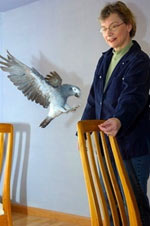 Michael also started an innovative parrot forum for people who are beginning to learn about parrots as well as experienced people - TheParrotForum.com. The forum includes ideas on trick training and flight training. This is particularly exciting because the idea of living with flighted birds is still somewhat grounded in the avian community - especially on the East Coast of the United States. Michael has an extensive Youtube library with a lot of "how to" videos that are quite professional. He also has a great deal of technical knowledge and has applied it with great success to his forums. One interesting adaptation is that Michael has people post their pictures to their chats so that it is more human and less likely that people will become combative or rude because it takes some of the anonymity out of the posting.
Michael also started an innovative parrot forum for people who are beginning to learn about parrots as well as experienced people - TheParrotForum.com. The forum includes ideas on trick training and flight training. This is particularly exciting because the idea of living with flighted birds is still somewhat grounded in the avian community - especially on the East Coast of the United States. Michael has an extensive Youtube library with a lot of "how to" videos that are quite professional. He also has a great deal of technical knowledge and has applied it with great success to his forums. One interesting adaptation is that Michael has people post their pictures to their chats so that it is more human and less likely that people will become combative or rude because it takes some of the anonymity out of the posting.
With over 20 years of parrot experience, Mona Delgado is a spokesperson for indoor freeflight of companion parrots. She is a co-founder of the Northwest Avian Flyers club and online group. Mona holds a particular affinity for African parrots. I have had a lot of email correspondence with Michael and I always enjoy reading about him and learning what he has taken on as a new challenge. He is an interesting young man with a lot of character and I look forward to see what he brings next to the table. Mona Delgado www.flyingparrotsinside.com Biography of Michael's Parrot AccomplishmentsPre-Parrot Starting from early childhood, Michael Sazhin has always been consumed with fascination for anything that flies. He developed an admiration for airplanes and flying machines which also extended to birds. He applied his photographic hobby to shooting birds with his Canon. It started with his first bird photo in Costa Rica of a Grackle poised to fly. From that point, he made many attempts to photograph birds not only on the ground but also in flight. From the nesting Penguins of Antarctica to the majestic flying Grey Crowned cranes in Tanzania, he captured the essence of birds and flight.
Starting from early childhood, Michael Sazhin has always been consumed with fascination for anything that flies. He developed an admiration for airplanes and flying machines which also extended to birds. He applied his photographic hobby to shooting birds with his Canon. It started with his first bird photo in Costa Rica of a Grackle poised to fly. From that point, he made many attempts to photograph birds not only on the ground but also in flight. From the nesting Penguins of Antarctica to the majestic flying Grey Crowned cranes in Tanzania, he captured the essence of birds and flight.
Photographing birds surely was not enough; Michael could not resist the temptation to try to be one. After receiving a glider flight for his 18th birthday, he was without a doubt hooked on flying. 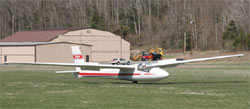 He pursued his lifelong dreams of flying by acquiring several pilot ratings and taking to the skies on nearly a weekly basis from then forth. He began his flying hobby with the purist form of flight: the sailplane. He enjoys riding convective thermals along side of vultures, hawks, and eagles, sometimes coming close enough to look the raptor in the eyes. He continued his pursuit for flight by acquiring additional ratings: single engine airplane, tailwheel, complex, and commercial pilot glider.1 He pursued his lifelong dreams of flying by acquiring several pilot ratings and taking to the skies on nearly a weekly basis from then forth. He began his flying hobby with the purist form of flight: the sailplane. He enjoys riding convective thermals along side of vultures, hawks, and eagles, sometimes coming close enough to look the raptor in the eyes. He continued his pursuit for flight by acquiring additional ratings: single engine airplane, tailwheel, complex, and commercial pilot glider.1
First Parrot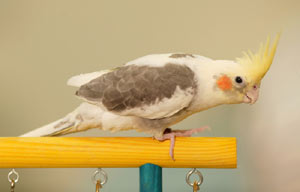 After living several years on his own, Michael decided to seek a pet to share his apartment with. From the start, he knew that he did not want a cat, dog, or any other typical mammalian pet. He sought a reasonably self sufficient pet that could have a closed living area but also be out and about. This ruled out many options and just before he was ready to give up his search for the optimal pet, a friend suggested to get a bird. Having absolutely no experience with birds up close, Michael was unsure about the feasibility of owning a bird for fear of it flying around all over the place and pooping everywhere. After some more discussions and brief research online, Michael decided to seek a handfed cockatiel because that was what his friend had. Without knowledge of specialized bird stores or bird breeders, he tried petcos and local pet stores with no success. By chance he came across a store that has a section just for birds and settled on buying a young Pied Cockatiel there. Michael was astonished to spend 3 times the price of the bird when it came to cage and all supplies but thought it would be well worth it. He named the Cockatiel, Spock. The name was neither in relation to the character from Star Trek nor to the noted Dr. Spock. Instead, it was an allusion to the rock band Spock's Beard which Michael listened to extensively at the time.
After living several years on his own, Michael decided to seek a pet to share his apartment with. From the start, he knew that he did not want a cat, dog, or any other typical mammalian pet. He sought a reasonably self sufficient pet that could have a closed living area but also be out and about. This ruled out many options and just before he was ready to give up his search for the optimal pet, a friend suggested to get a bird. Having absolutely no experience with birds up close, Michael was unsure about the feasibility of owning a bird for fear of it flying around all over the place and pooping everywhere. After some more discussions and brief research online, Michael decided to seek a handfed cockatiel because that was what his friend had. Without knowledge of specialized bird stores or bird breeders, he tried petcos and local pet stores with no success. By chance he came across a store that has a section just for birds and settled on buying a young Pied Cockatiel there. Michael was astonished to spend 3 times the price of the bird when it came to cage and all supplies but thought it would be well worth it. He named the Cockatiel, Spock. The name was neither in relation to the character from Star Trek nor to the noted Dr. Spock. Instead, it was an allusion to the rock band Spock's Beard which Michael listened to extensively at the time.
He brought the bird home in a cardboard box and was not even sure how to transfer it from the box to the cage. He was more scared of hurting or scaring the bird than the thought of getting bitten so he had difficulty getting a hold of the bird but finally got it into the cage. Prompted by this lack of handling capability and knowledge, Michael proceeded to the internet to seek information about how to handle his new companion that he knew very little about. In his searches of the net, he was able to find little helpful information and birdtricks was dominating most of the results. Reluctant to pay the exorbitant price and cautious because the website looks like a complete scam, he decided the risk was worth the try for the sake of learning how to get his new bird not to bite and eventually be able to handle it. The birdtricks course made promises of showing everything you need to know about bird handling and that it is guaranteed to work from the smallest to largest birds. During the wait to receive the training DVDs by mail, Michael had come across some target training videos on youtube and by the time the package arrived, he had already trained Spock to follow the target stick around inside the cage. Michael expected that if the free preview videos from birdtricks were this helpful, that the expensive DVD would be even more so. To his great disappointment this was not really the case. The free target training video proved to be more helpful for developing basic handling than the obsolete training DVD which suggested flooding rather than training. The DVD went extensively into trick training and talked about things to do with the parrot outside of the cage but mentioned nothing about getting the parrot out of the cage for the first time to begin with. 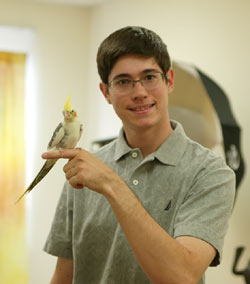 For a newbie that has never so much as held a bird, this was a far greater dilemma than how to get it to shake its head on cue. Furthermore, the course was featured around large parrots and the techniques did not seem to scale down to a Cockatiel which led to further disappointment with the course. For a newbie that has never so much as held a bird, this was a far greater dilemma than how to get it to shake its head on cue. Furthermore, the course was featured around large parrots and the techniques did not seem to scale down to a Cockatiel which led to further disappointment with the course.
Michael discovered the tremendous advantage of using positively reinforced target training to lure the parrot onto his hand rather than using any forceful methods. It was a win/win situation for both. Michael avoided getting bitten and the Cockatiel was not frightened. In just one month, Michael had already target trained the Cockatiel, taught it to step up, and nearly completed training it to show its wings. Sadly, the young bird got sick and died shortly after. The tremendous disappointment did not discourage Michael from parrot ownership but instead gave him a drive to learn about parrot care in depth to the greatest extent possible. Just before the bird showed any signs of illness, Michael had ordered a course about teaching tricks to small parrots but the course had not arrived until after the bird died. Instead of returning the DVDs on the basis of the bird passing away, Michael instead kept them and vowed that he would put all this new learning to good use and stick to parrot ownership.2 Kili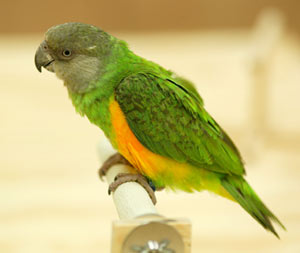 Not long after, Michael began to research a new parrot because his thirst for learning about parrots and training had only just begun. He was not seeking a replacement in as much as a companion for life that would grow with him. He narrowed his search down to three species of small sized parrots including Sun Conure, Senegal Parrot, and Hahns Macaw. He was not sure which to choose but from his preliminary research they all seemed compelling and they were priced in increasing increments of $100 which was manageable. He equally considered breeders while also searching specialized bird stores. None of the local breeders appealed to him so he began checking out the available bird stores. The advantage of buying at a store was that a selection of species was available which made choosing for the inexperienced owner much simpler. The choice was actually quite simple. The Sun Conures turned out to be unbearably noisy and the Hahn's Macaw incredibly skittish. However, the one remaining Senegal Parrot caught Michael's attention immediately. It was calm and easy going. In contrast to the other two parrots, this one Michael could hold off the start and even scratch without biting or flight. He bought Kili and took her home the same day on September 18, 2008.3
Not long after, Michael began to research a new parrot because his thirst for learning about parrots and training had only just begun. He was not seeking a replacement in as much as a companion for life that would grow with him. He narrowed his search down to three species of small sized parrots including Sun Conure, Senegal Parrot, and Hahns Macaw. He was not sure which to choose but from his preliminary research they all seemed compelling and they were priced in increasing increments of $100 which was manageable. He equally considered breeders while also searching specialized bird stores. None of the local breeders appealed to him so he began checking out the available bird stores. The advantage of buying at a store was that a selection of species was available which made choosing for the inexperienced owner much simpler. The choice was actually quite simple. The Sun Conures turned out to be unbearably noisy and the Hahn's Macaw incredibly skittish. However, the one remaining Senegal Parrot caught Michael's attention immediately. It was calm and easy going. In contrast to the other two parrots, this one Michael could hold off the start and even scratch without biting or flight. He bought Kili and took her home the same day on September 18, 2008.3
Finding a suitable name was not easy and he went through a list without being able to pinpoint the right one. He was trying out the name Kiwi but it wasn't exactly working out. His young sister came to know that he had a new parrot named Kiwi but she mispronounced it as Kili. This new name sounded much better and had that unique vibe that was certainly missing in the original name. So thus the name Kili came to be.4 Soon he learned that the parrot was a DNA sexed female and had hatched on June 16, 2008. 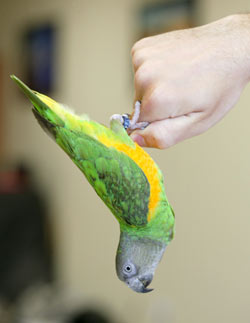 Just a few days after bringing Kili home, Michael already began clicker and target training her. He then began teaching her one trick after another since she was picking them up so easily. Within the first six months of owning Kili, he had already taught her the significance of the clicker, target stick training, wave, shake head, nod head, fetch, bowling, turn around, bat, and play dead.5 6 Each training success served as encouragement to keep going and training even more tricks to Kili.
Just a few days after bringing Kili home, Michael already began clicker and target training her. He then began teaching her one trick after another since she was picking them up so easily. Within the first six months of owning Kili, he had already taught her the significance of the clicker, target stick training, wave, shake head, nod head, fetch, bowling, turn around, bat, and play dead.5 6 Each training success served as encouragement to keep going and training even more tricks to Kili.
Awareness of the deadly threat of Teflon/PTFE, led Michael to scrap all of his non-stick pans and appliances. However, this was only the beginning of a quest to find convenient alternatives to use for things like cooking meat, frying things, and making waffles. He went through stainless steel and several other alternatives until he settled on cast iron. He came to realize that cast iron can be as good if not better than Teflon as a cooking surface.7 Although he had made a couple videos of Kili previously, he did not go public with them initially. On April 29, 2009, Michael launched the highly popular kiliparrot youtube channel. Thanks to a convenient new HD video camera that he has received for a recent birthday, Michael had gained not only the tools but also the desire for documenting the results of his parrot training. He made a 30 second video of Kili bowling which became a nearly instant hit online.8 9 On the basis of his successful application of birdtricks products for training his parrot, Michael was asked to write for the birdtricks blog. He then released the Play Dead and Other Tricks video which became very popular and still remains the #1 Senegal Parrot video on youtube.6 Besides learning from nearly every product released by birdtricks, Michael extensively studied the works of Tani Robar, Mattie Sue Athan, Grindol Roudybush, Barbara Heidenreich, Jean Pattison, Steve Martin, Susan Friedman, Irene Pepperburg, Ornithology by Frank B. Gill, Parrots - A Guide to the Parrots of the World by Tony Juniper and Mike Parr, The Manual of Parrot Behavior edited by Andrew Luescher, etc. In college, he minored in psychology with a particular interest in animal/comparative behavioral psychology and its application to training.1 Duke On Thursday May 21, 2009, Michael bought a dark eyed clear Budgerigar as a gift for his then girlfriend. He found that the best way to get her involved with parrots was to let her train and care for one of her own.10 They named him Duke in reference to the so named Genesis album but also the regal nature of all white feathers.11 Unlike with Kili, Michael videod training Duke right from the very beginning. Duke learned target training, to jump through a ring, turn around, and crawl through a toilet paper tube in very little time.10 12 13 By using refined training techniques, he was able to teach tricks to Duke quicker and more efficiently than originally with Kili.12
On Thursday May 21, 2009, Michael bought a dark eyed clear Budgerigar as a gift for his then girlfriend. He found that the best way to get her involved with parrots was to let her train and care for one of her own.10 They named him Duke in reference to the so named Genesis album but also the regal nature of all white feathers.11 Unlike with Kili, Michael videod training Duke right from the very beginning. Duke learned target training, to jump through a ring, turn around, and crawl through a toilet paper tube in very little time.10 12 13 By using refined training techniques, he was able to teach tricks to Duke quicker and more efficiently than originally with Kili.12
Around the same time as getting Duke, Michael began to make greater efforts at socializing Kili to other people to reduce aggression and one person birdedness. He brought her along for car rides and outings to teach her to be around more people.14 Michael built a slide from scratch and taught both parrots to go down the slide.15 He continued teaching more advanced tricks to Kili including: piggy bank, 4 piece puzzle, improved wings trick, bat, and play dead.16 17 18 19 20 Some of those tricks took as much as a month or more to train but with patience and daily training, he achieved his goals in teaching the parrot these tricks. Close to Kili's first birthday, Kili flew for the first time ever. But it was not with her own wings that she flew but in an airplane. Since Kili was clipped at the time Michael acquired her, she never had a chance to fly. However, she enjoyed flying in airplanes and calmly sat on Michael's shoulder and preened while he focused on flying and landing the airplane.21 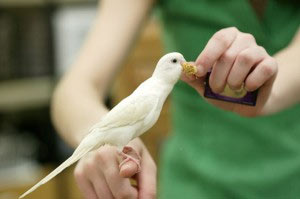 Constantly on the look out for new trick ideas, Michael spent hours browsing stores on the lookout for new props to use. He came up with an original trick to have a budgie go through a slinky. The training technique was similar as going through a ring or tube but it allowed the viewers to see the bird as it would scurry through. He later adapted the same trick for his Senegal Parrot as well.22 As part of his blogging, Michael analyzed the importance of rationing everything that can be considered good for parrots (not just food) to be able to later provide those as rewards for favorable behavior.23
Constantly on the look out for new trick ideas, Michael spent hours browsing stores on the lookout for new props to use. He came up with an original trick to have a budgie go through a slinky. The training technique was similar as going through a ring or tube but it allowed the viewers to see the bird as it would scurry through. He later adapted the same trick for his Senegal Parrot as well.22 As part of his blogging, Michael analyzed the importance of rationing everything that can be considered good for parrots (not just food) to be able to later provide those as rewards for favorable behavior.23
One of his pivotal early achievements was the production of a biting solution video which demonstrated the use of positive reinforcement based training to teach a parrot to step up to come out of the cage without biting. The video was highly successful along with a corresponding article he wrote for it.24 Around the same time was the first independent mention of Kili's video from an outside source on About.com.25 For a period of time, Michael was responsible for developing original tricks with articles/videos for the BirdTricks Parrot Magic series.26 He developed a magic cups routine with Kili and made a glass of milk change into a budgie. The budgie through slinky trick was also featured in this series.22 Taking Flight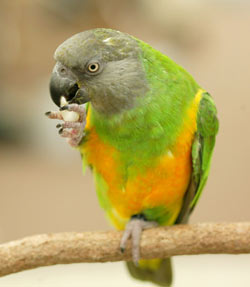 Getting Kili used to flying was certainly a challenge. She had been clipped prior to learning how to fly so when she got her feathers back, she had no clue what to do. So Michael developed a technique for targeting Kili back and forth from perch to perch that he had made. At first the distance was very small and Kili could just walk across but he progressively spread the distance until she would have to hop and fly. Unfortunately as soon as the gap got big enough to require flight, Kili would refuse to cross. Then Michael put the perches closer and continued. Sometimes while stepping across the wide gap, Kili would slip which required her to flap to get her balance. Thus she learned to flap as she stepped across the gap which eventually led to flight. Michael extended this to recall flight training by targeting Kili to fly to his hand rather than to the perch.27 28
Getting Kili used to flying was certainly a challenge. She had been clipped prior to learning how to fly so when she got her feathers back, she had no clue what to do. So Michael developed a technique for targeting Kili back and forth from perch to perch that he had made. At first the distance was very small and Kili could just walk across but he progressively spread the distance until she would have to hop and fly. Unfortunately as soon as the gap got big enough to require flight, Kili would refuse to cross. Then Michael put the perches closer and continued. Sometimes while stepping across the wide gap, Kili would slip which required her to flap to get her balance. Thus she learned to flap as she stepped across the gap which eventually led to flight. Michael extended this to recall flight training by targeting Kili to fly to his hand rather than to the perch.27 28
During a brief encounter with Chris Biro and his freeflight list, Michael developed a strong distrust in "professional" parrot trainers and experts. The incident shaped strong beliefs in the importance of freedom of information when it comes to parrot training. This was the spark that set the course of his involvement in the parrot community to come.29 The only good thing that came out of the short experience on that list was coming in contact with Mona who became not only a source of advice but an inspiration for his indoor flight pursuits.30 Using his strong bond and existing training history with Kili, Michael used this to continue working on flight recall with Kili. After just 2 weeks since she started flying, Michael was already able to recall her 60ft across the room.27 31 By the end of just one month of flight training, he was able to recall Kili anywhere indoors thanks to positive reinforcement training.33 Michael learned how to trim parrot nails himself and practiced on the budgie.32 He wrote an expose about the abuse of budgies at the local street carnival.34 Also he solved the problem of Kili escaping her cage by using a simple clip modification on the food bowl doors.35 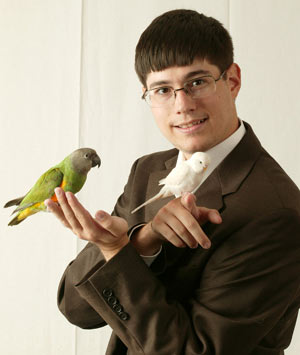 The budgerigar Duke was taught additional tricks to the point where he knew target, ring, turn around, toilet paper tube, bat, slide, wave and fetch. Michael demonstrated that even budgies are intelligent parrots and quite easily trainable. This strengthened and refined his training techniques by making them scalable to birds of other sizes/capabilities.36 At this point Michael began teaching flighted tricks to Kili such as flying to fetch a ball and to fly to do previously known tricks.27 37 Michael invented unique parrot magic tricks with Kili including the parrot coin cups trick and magic coin drawer.26 He also developed original budgie magic tricks.38
The budgerigar Duke was taught additional tricks to the point where he knew target, ring, turn around, toilet paper tube, bat, slide, wave and fetch. Michael demonstrated that even budgies are intelligent parrots and quite easily trainable. This strengthened and refined his training techniques by making them scalable to birds of other sizes/capabilities.36 At this point Michael began teaching flighted tricks to Kili such as flying to fetch a ball and to fly to do previously known tricks.27 37 Michael invented unique parrot magic tricks with Kili including the parrot coin cups trick and magic coin drawer.26 He also developed original budgie magic tricks.38
On September 30, 2009 Michael Sazhin started theparrotforum as a place to answer questions from his youtube subscribers and to create an alternative safe place to discuss parrots without politics or favoritism. Michael was fed up with other over-moderated communities or places where members had to suck up to moderators or experts in order to get help. He created a very lenient set of rules to help facilitate discussion rather than shut it down.39 Meanwhile, several clips of Kili performing tricks were used by Cineflix-Nextfilm Productions for a BBC children's program about animals. Things came to an abrupt halt on October 18, 2009 with Duke's end. The tragic and unexpected death of Duke the budgerigar turned the direction of Michael's interaction with the public.40 He resigned from BirdTricks development later that month. Advanced FlightDespite the changing situation, Michael continued teaching advanced flight tricks to Kili.27 41 He wrote the highly popular "How to Teach Parrot to Step Up and Come Out of Cage" intro to taming/training article based on the video to explain how to do it. This article has received over 4,500 views to date.42 Following, he wrote the controversial "Counterarguments to Tani Robar's Opposition to Clickers" with point by point responses to Tani's arguments in her book. He wrote from experience and practical application to demonstrate that Tani's reluctance to clickers was sooner an excuse than sound training advice.43 Michael trained Kili to do ring on peg by color and then adapted it to a flighted version.27 44Eventually, Michael began considering getting another parrot. At first he considered a Meyer's Parrot but soon began to take greater interest in African Greys.45 He continued practicing flight with Kili and worked on advanced flight maneuvers such as hide and seek, up/down stairs flights, and recall flying around corners.46 47 He cowrote "Senegal Parrot Information and FAQ" with Mona and other writers to create one of the most comprehensive Senegal owner reviews of these parrots which collected over 5,000 views.48 Michael found a breeder and almost put down a deposit on an African Grey baby but problems with the breeder cause the deal to fall through at the last minute. This led Michael to consider a Cape Parrot vs. African Grey and thus he came in contact with Jean Pattison of African Queen Aviaries.49 She recommended to buy a Cape from Linda Pietroski but it did not work out because she refused to raise a flighted parrot and clips them before they can fledge.50 Michael taught Kili to say "hello" and put it on cue. Eventually he developed "hello" as a contact call for Kili to seek attention rather than shrieking.51 He performed with Kili 20 tricks in 2 minutes for the world record video to show Kili's training success. In the video, Kili demonstrates 20 cued tricks in 2 minutes uncut. This became the most popular video of Kili and has received over 200,000 views. It is not only the post viewed Senegal Parrot video on youtube, but also the most viewed (non-televised) parrot tricks video on all of youtube as well.52 Michael came up with a new and original trick to teach Kili yet again and taught her the parrot darts trick.53 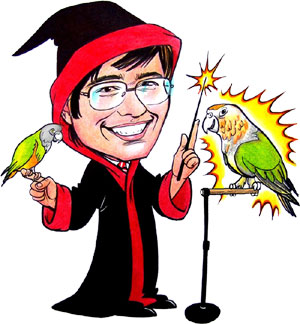 Kili developed a phobia of the harness after wearing it the first time which posed a new training challenge. Michael had to start over again and not only train Kili to wear the harness but to start with eliminating her fear of it. He created a video and wrote articles to share the training progress. In just 3 days he went from a terrified parrot that would flee at the sight of the harness to one that would voluntarily stick its head into the harness to assist in putting it on. Michael began taking Kili outside wearing her harness and started training outdoor harness recall flights.54 He researched ways to improve the reliability of flight recalls and performed his own scientific study about the impact of variable ratio reinforcement schedules on motivation and flight training.55 He observed and photographed the wild Monk Parakeets of Brooklyn.56 Michael refined his taming methods to eliminate one-person-birdedness so that other people could hold Kili without getting bitten and she has become quite a social parrot since.57
Kili developed a phobia of the harness after wearing it the first time which posed a new training challenge. Michael had to start over again and not only train Kili to wear the harness but to start with eliminating her fear of it. He created a video and wrote articles to share the training progress. In just 3 days he went from a terrified parrot that would flee at the sight of the harness to one that would voluntarily stick its head into the harness to assist in putting it on. Michael began taking Kili outside wearing her harness and started training outdoor harness recall flights.54 He researched ways to improve the reliability of flight recalls and performed his own scientific study about the impact of variable ratio reinforcement schedules on motivation and flight training.55 He observed and photographed the wild Monk Parakeets of Brooklyn.56 Michael refined his taming methods to eliminate one-person-birdedness so that other people could hold Kili without getting bitten and she has become quite a social parrot since.57
Throughout the first half of 2010, Michael had kept in contact with Jean Pattision with the hopes of acquiring a Cape Parrot.49 In April he put down a deposit for a Cape Parrot baby. His parrot forum expanded to 3rd place on google, 600+ members, and 600+ subscribers on youtube.58 59 He started the TrainedParrot blog to chronicle the adventures and training experiences with the new Cape Parrot from the very start.60 He received Truman the Cape Parrot on June 22, 2010 and here begins the parrot training blog! References(1) http://www.birdtricks.com/blog/introducing-mike-and-kili-the-senegal-parrot/(2) http://spock.sazhin.net/ (3) http://kili.sazhin.net/photos/kili.jpg (4) http://www.birdtricks.com/blog/naming-my-senegal-parrot/ (5) http://www.youtube.com/watch?v=MZR8j-9vQno (6) http://www.youtube.com/watch?v=0QCmP0CebB8 (7) http://www.birdtricks.com/blog/alternatives-to-deadly-non-stick-cookware/ (8) http://www.youtube.com/watch?v=cSDNJsrBX5Q (9) http://www.birdtricks.com/blog/teaching-my-senegal-parrot-to-bowl/ (10) http://www.birdtricks.com/blog/target-training-budgie/ (11) http://theparrotforum.com/viewtopic.php?f=7&t=24&p=52#p52 (12) http://www.birdtricks.com/blog/training-budgie-to-turn-around/ (13) http://www.birdtricks.com/blog/teaching-budgie-to-crawl-through-tube/ (14) http://www.birdtricks.com/blog/car-outing-for-parrot/ (15) http://www.youtube.com/watch?v=aLvxWsoiAmc (16) http://www.youtube.com/watch?v=T-x8ip1TKfQ (17) http://www.youtube.com/watch?v=SNgprLrvMVY (18) http://www.youtube.com/watch?v=yq6zgeMXHWs (19) http://www.youtube.com/watch?v=IGtI0A4HQhk (20) http://www.youtube.com/watch?v=iqQPvSj5Ido (21) http://www.birdtricks.com/blog/my-senegal-parrots-first-flight-ever/ (22) http://www.birdtricks.com/blog/budgie-runs-through-a-slinky/ (23) http://www.birdtricks.com/blog/healthy-balance-part-1/ http://www.birdtricks.com/blog/healthy-balance-part-2/ http://www.birdtricks.com/blog/healthy-balance-part-3/ http://www.birdtricks.com/blog/healthy-balance-part-4/ (24) http://www.youtube.com/watch?v=LbXHrqqEIp4 (25) http://birds.about.com/b/2009/07/10/funny-bird-friday-kili-the-senegal-parrot.htm (26) http://www.youtube.com/watch?v=Xc2Uypg3zJA (27) http://theparrotforum.com/viewtopic.php?f=15&t=228 (28) http://www.youtube.com/watch?v=sSwWNGJ_0Jk (29) http://pets.groups.yahoo.com/group/Freeflight/message/74989 (30) http://pets.groups.yahoo.com/group/Freeflight/message/74976 (31) http://www.youtube.com/watch?v=DxersUykAd8 (32) http://www.youtube.com/watch?v=g3KKmDFv0T8 (33) http://www.youtube.com/watch?v=qmuygqqTDqg (34) http://www.birdtricks.com/blog/carnival-abuse-of-budgies/ (35) http://www.birdtricks.com/blog/the-great-escape-case-closed/ (36) http://www.youtube.com/watch?v=Ya8HgsmiSkU (37) http://www.youtube.com/watch?v=I9hWGgaQYyU (38) http://www.youtube.com/watch?v=vn0ohRbafj0 (39) http://theparrotforum.com/viewtopic.php?f=6&t=2 (40) http://theparrotforum.com/viewtopic.php?f=7&t=214 (41) http://www.youtube.com/watch?v=Z-cdanh5Xzw (42) http://theparrotforum.com/viewtopic.php?f=11&t=227 (43) http://theparrotforum.com/viewtopic.php?f=17&t=278 (44) http://www.youtube.com/watch?v=fD5g4VlTS78 (45) http://theparrotforum.com/viewtopic.php?f=12&t=293 (46) http://www.youtube.com/watch?v=0VNhYoBwQWA (47) http://www.youtube.com/watch?v=ikVOCoo4DRo (48) http://theparrotforum.com/viewtopic.php?f=12&t=348 (49) http://www.africanqueenaviaries.com/ (50) http://theparrotforum.com/viewtopic.php?f=12&t=550 (51) http://www.youtube.com/watch?v=5zwZwXiEoWc (52) http://www.youtube.com/watch?v=unO5whIUF-M (53) http://www.youtube.com/watch?v=ZpTaErjoDTs (54) http://theparrotforum.com/viewtopic.php?f=15&t=1329 (55) http://theparrotforum.com/viewtopic.php?f=15&t=1439 (56) http://theparrotforum.com/viewtopic.php?f=7&t=1468 (57) http://theparrotforum.com/viewtopic.php?f=11&t=1528 (58) http://theparrotforum.com/viewtopic.php?f=6&t=935 (59) http://theparrotforum.com/viewtopic.php?f=6&t=1908 (60) http://trainedparrot.com/ |
| Trained Parrot Home | About | Sitemap | Parrot Training Perches | The Parrot Forum | Videos | Youtube Channel |
|
Trained Parrot is a blog about how to train tricks to all parrots and parakeets. Read about how I teach tricks to Truman the Brown Necked Cape Parrot including flight recall, shake, wave, nod, turn around, fetch, wings, and play dead. Learn how you can train tricks to your Parrot, Parrotlet, Parakeet, Lovebird, Cockatiel, Conure, African Grey, Amazon, Cockatoo or Macaw. This blog is better than books or DVDs because the information is real, live, and completely free of charge. If you want to know how to teach your parrot tricks then you will enjoy this free parrot training tutorial.
Trained Parrot site content Copyright 2010-2020 Michael Sazhin. Reproduction of text, images, or videos without prior permission prohibited. All rights reserved. |